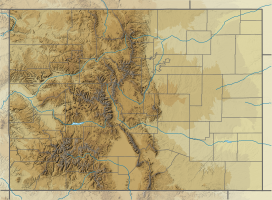geo.wikisort.org - Mountains
Golden Horn is a 13,780-foot-elevation (4,200 meter) mountain summit located on the shared boundary of San Juan County with San Miguel County, in southwest Colorado, United States.[4] It is situated nine miles west of the community of Silverton, on land managed by San Juan National Forest and Uncompahgre National Forest. Golden Horn is part of the San Juan Mountains which are a subset of the Rocky Mountains, and is west of the Continental Divide. It ranks as the 116th-highest peak in Colorado,[2] and topographic relief is significant as the west aspect rises 3,800 feet (1,160 meters) in approximately 1.5 mile. The mountain's name, which has been officially adopted by the United States Board on Geographic Names, was in use in 1906 when Henry Gannett published it in A Gazetteer of Colorado.[4][6]
| Golden Horn | |
|---|---|
 East aspect | |
| Highest point | |
| Elevation | 13,780 ft (4,200 m)[1][2] |
| Prominence | 360 ft (110 m)[3] |
| Parent peak | Vermilion Peak (13,894 ft)[2] |
| Isolation | 0.42 mi (0.68 km)[2] |
| Coordinates | 37°48′17″N 107°49′29″W[4] |
| Naming | |
| Etymology | Golden Horn |
| Geography | |
 Golden Horn Location in Colorado  Golden Horn Golden Horn (the United States) | |
| Location | San Juan / San Miguel counties Colorado, US |
| Parent range | Rocky Mountains San Juan Mountains |
| Topo map | USGS Ophir |
| Climbing | |
| Easiest route | class 2+[2] Southwest Ridge[5] |
Climate
According to the Köppen climate classification system, Golden Horn is located in an alpine subarctic climate zone with long, cold, snowy winters, and cool to warm summers.[7] Due to its altitude, it receives precipitation all year, as snow in winter, and as thunderstorms in summer, with a dry period in late spring. Precipitation runoff from the mountain drains west into tributaries of the Dolores River, and east to the Animas River via Mineral Creek.
See also
- Mountains of San Juan County, Colorado
- Mountains of San Miguel County, Colorado

References
- Gerry Roach, Jennifer Roach, Colorado's Thirteeners, 13,800 to 13,999 Feet: From Hikes to Climbs, 2001, Fulcrum Pub., ISBN 9781555914196, page 295.
- "Golden Horn - 13,780' CO". listsofjohn.com. Retrieved 2021-07-10.
- "Golden Horn, Colorado". Peakbagger.com.
- "Golden Horn". Geographic Names Information System. United States Geological Survey. Retrieved 2021-07-10.
- James Dziezynski, Climbing Colorado's Thirteeners: The Best Hikes and Scrambles Over 13,000 Feet, 2021, Falcon Guides, ISBN 9781493046218, page 198.
- Henry Gannett, Gazetteer of Colorado, 1906, US Government Printing Office, page 77.
- Peel, M. C.; Finlayson, B. L.; McMahon, T. A. (2007). "Updated world map of the Köppen−Geiger climate classification". Hydrol. Earth Syst. Sci. 11. ISSN 1027-5606.
External links
- Weather forecast: Golden Horn
- 1874 image of Golden Horn: Commons
Другой контент может иметь иную лицензию. Перед использованием материалов сайта WikiSort.org внимательно изучите правила лицензирования конкретных элементов наполнения сайта.
WikiSort.org - проект по пересортировке и дополнению контента Википедии